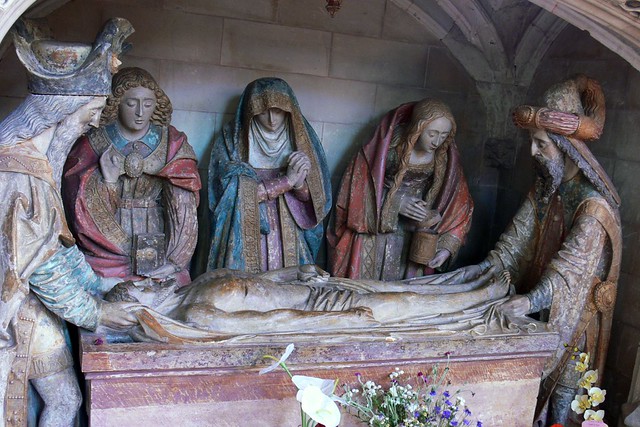Easter Sepulchre - Neufchâtel-en-Bray, France

This, late 15th–early 16th century, Easter Sepulchre group depicts the moment of Christ’s entombment, a subject traditionally shown in Holy Week rituals in northern France and the Low Countries. The scene is arranged beneath a shallow architectural canopy, gathering together the key figures who, according to the Gospels, prepared Christ’s body for burial.
Christ’s lifeless figure is laid out with great tenderness, his elongated body placed upon a stone sarcophagus. At the left, Joseph of Arimathea, richly dressed and wearing an ornate turban, assists in lowering the shroud. Opposite him stands Nicodemus, also elaborately clothed, gently supporting the body. Their noble attire, rendered in still-surviving polychromy, reflects their status as wealthy Jewish elders who cared for Jesus after the Crucifixion.
Behind them, three Holy Women witness the burial. The central figure—the Virgin Mary—is shown with downcast eyes, hands clasped in grief. Beside her, St John the Evangelist appears in the traditional youthful form, touching the Book of the Gospels he carries. On the right stands Mary Magdalene, identifiable by the ointment jar used to anoint Christ’s body.
The group is distinguished by the emotional restraint typical of late medieval Norman sculpture: sorrow is conveyed not by dramatic gestures but through gentle inclination of heads, careful drapery folds, and the subdued, contemplative rhythm of the figures. Much of the original paint survives, including delicate patterning on garments and traces of gilding.
Easter Sepulchres were used during the liturgy of Holy Week: on Good Friday, a sculpture of the dead Christ was placed in the sepulchre; on Easter morning, it was removed to symbolise the Resurrection. Although many such ensembles were destroyed in later centuries, the Neufchâtel-en-Bray group remains a rare and eloquent survival of this tradition in Normandy.
